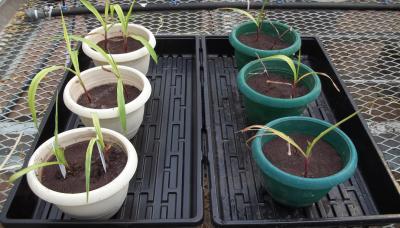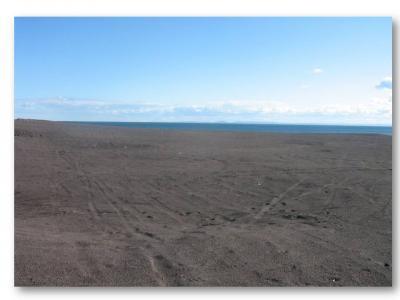Scientists have known for years that together, bacteria and plants can remediate contaminated sites. Ramakrishna Wusirika, of Michigan Technological University, has determined that how you add bacteria to the mix can make a big difference.
He has also shed light on the biochemical pathways that allow plants and bacteria to clean up some of the worst soils on the planet while increasing their fertility.
Wusirika, an associate professor of biological sciences, first collected stamp sands near the village of Gay, in Michigan's Upper Peninsula. For decades, copper mining companies crushed copper ore and dumped the remnants—an estimated 500 million tons of stamp sand—throughout the region. Almost nothing grows on these manmade deserts, which are laced with high concentrations of copper, arsenic and other plant-unfriendly chemicals.
Then, Wusirika and his team planted maize in the stamp sand, incorporating bacteria in four different ways:
- mixing it in the stamp sand before planting seed;
- coating seed with bacteria and planting it;
- germinating seeds and planting them in soil to which bacteria were added; and
- the conventional method, immersing the roots of maize seedlings in bacteria and planting them in stamp sand.
After 45 days, the team uprooted the plants and measured their dry weight. All maize grown with bacteria was significantly more vigorous—from two to five times larger—than the maize grown in stamp sand alone. The biggest were those planted as seedlings or as germinated seeds.
However, when the researchers analyzed the dried maize, they made a surprising discovery: the seed-planted maize took up far more copper as a percentage of dry weight. In other words, the smaller plants pulled more copper, ounce per ounce, out of the stamp sands than the bigger ones.

Maize plants grown in stamp sand inoculated with bacteria, left, were considerably more robust than those grown in stamp sand alone, right. Research led by Michigan Technological University's Ramakrishna Wusirika could lead to new remediation techniques for soils contaminated by copper and other heavy metals.
(Photo Credit: Ramakrishna Wusirika)
That has implications for land managers trying to remediate contaminated sites, or even for farmers working with marginal soils, Wusirika said. The usual technique—applying bacteria to seedlings' roots before transplanting—works fine in the lab but would be impractical for large-scale projects. This could open the door to simple, practical remediation of copper-contaminated soils.
But the mere fact that all the plants grown with bacteria did so well also piqued his curiosity. "When we saw this, we wondered what the bacteria were doing to the soil," Wusirika said. "Based on our research, it looks like they are improving enzyme activity and increasing soil fertility," in part by freeing up phosphorus that had been locked in the rock.
The bacteria are also changing copper into a form that the plants can take up. "With bacteria, the exchangeable copper is increased three times," he said. "There's still a lot of copper that's not available, but it is moving in the right direction."
By analyzing metabolic compounds, the team was able to show that the bacteria enhance photosynthesis and help the plants make growth hormones. Bacteria also appear to affect the amount phenolics produced by the maize. Phenolics are antioxidants similar to those in grapes and red wine.
Compared to plants grown in normal soil without bacteria, plants grown in stamp sand alone showed a five-fold increase in phenolics. However, phenolics in plants grown in stamp sand with bacteria showed a lesser increase.
"Growing in stamp sand is very stressful for plants, and they respond by increasing their antioxidant production," Wusirika said. "Adding the metal-resistant bacteria enables the plants to cope with stress better, resulting in reduced levels of phenolics."
"There's still a lot to understand here," he added. "We'd like to do a study on stamp sands in the field, and we'd also like to work with plants besides maize. We think this work has applications in organic agriculture as well as remediation."

Nothing grows on the stamp sands near Gay, Mich., which are remnants from the processing of ore in Michigan's Copper Country. A new study at Michigan Technological University could yield new ways to remediate this polluted mine waste.
(Photo Credit: Ramakrishna Wusirika)